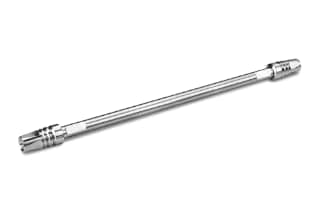
|
Chemistry |
Phenyl |
|
Separation Mode |
Reversed Phase |
|
Particle Substrate |
Hybrid |
|
pH Range Min |
1 pH |
|
pH Range Max |
12 pH |
|
Maximum Pressure |
18000 psi (1240 Bar) |
|
Endcapped |
Yes |
|
Bonding Technology |
Phenyl-Hexyl |
|
Silanol Activity |
Low |
|
Particle Shape |
Spherical |
|
Particle Size |
1.7 µm |
|
Endfitting Type |
Parker-style |
|
Pore Size |
130 Å |
|
Format |
Column |
|
Surface Area |
185 |
|
System |
UPLC, UHPLC |
|
Particle Technology |
BEH |
|
USP Classification |
L11 |
|
Inner Diameter |
2.1 mm |
|
Length |
150 mm |
|
Carbon Load |
15 % |
|
eCord |
Yes |
|
UNSPSC |
41115709 |
|
Brand |
ACQUITY UPLC |
|
Product Type |
Columns |
|
Units per Package |
3 pk |

ACQUITY UPLC BEH Phenyl Column, 130Å, 1.7 µm, 2.1 mm X 150 mm, 3/pk
The Waters ACQUITY UPLC BEH Phenyl Columns are designed to enhance the selectivity in straight-chain alkyl columns, especially for analytes with aromatic rings. With this sorbent and the XBridge BEH Phenyl, you get the most chemically stable phenyl sorbent on the market, with ultra-low column bleed and an extended column lifetime.
The only columns built, tested, and certified to withstand the pressures of UPLC Technology are ACQUITY UPLC columns, which are the most technologically advanced LC columns ever created. These columns are the first and only columns that allow separation scientists to achieve maximum speed, sensitivity, and resolution without compromising. These are based on extremely efficient 1.7 m Bridged Ethylene Hybrid (BEH) particles and 1.8 m High Strength Silica (HSS) particles. The particles and chemistries used in the ACQUITY UPLC column series were carefully selected to provide the best possible combination of ultra-high efficiency, a wide pH range, and complimentary high selectivity. The only columns suggested for engagement with ACQUITY UPLC Systems are ACQUITY UPLC BEH columns and ACQUITY UPLC HSS columns.
Particularly compared to other commercially available phenyl columns, the ACQUITY UPLC BEH Phenyl column provides industry-leading pH stability, batch-to-batch reproducibility, and outstanding peak shape for all analyte types. With the ACQUITY UPLC BEH Phenyl Columns, you can reduce the chance of technique variation due to changes in chromatographic media batch or column consistency. Using a tri-functionally bound phenyl-hexyl ligand, they are synthesized under the most stringent ISO 9001 standards and rigorous process control.
The 2.1 mm I.D. Waters ACQUITY UPLC BEH Phenyl Column is suitable for the analysis of analytes with pore size 130Å, and particle size 1.7 µm, and offers a wide pH stability range (1-12). Browse through our brochure or our website to shop for lab equipment to fulfill all your laboratory needs.
You may also be interested in ACQUITY UPLC BEH Phenyl VanGuard Pre-column, 130Å, 1.7 µm, 2.1 mm X 5 mm, 3/pk; ACQUITY BEH Phenyl columns provide complementary selectivity to C18 stationary phases, especially for polyaromatic compounds. This sorbent, along with the XBridge BEH Phenyl, provides you with the most chemically stable phenyl sorbent on the market and provides you with ultra-low column bleed, long column lifetimes, and excellent peak shape. The VanGuard pre-column connects directly to the inlet of the ACQUITY UPLC column, which minimizes extra column volumes and reduces leaking by eliminating additional connections.
What Is The Definition Of Chromatography Resolution?
Resolution measurements play a crucial role in optimizing separations as they depend on two fundamental aspects of the chromatographic process: peak width and retention time. By evaluating and manipulating these inherent properties, resolution can be enhanced. Peak width reflects the degree of separation between adjacent peaks, while retention time signifies the duration analytes spend on the stationary phase. Understanding and controlling these factors allow for fine-tuning separation conditions and achieving optimal resolution, leading to improved chromatographic performance.